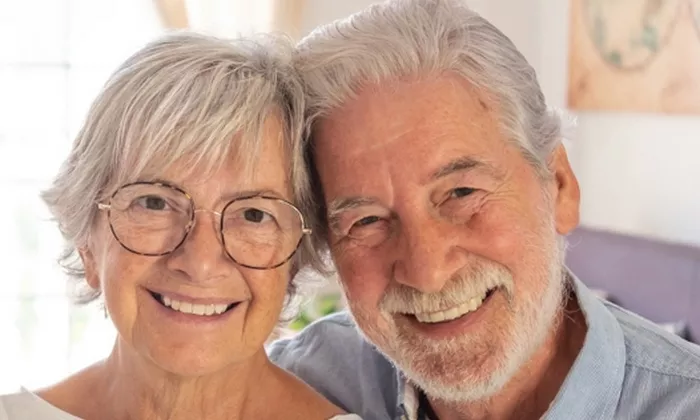Over the last two decades, the percentage of U.S. adults aged 65 and older who have lost all their teeth has dropped significantly—from about 32% to a record low of 17%, according to the latest data from the National Institute of Dental and Craniofacial Research. In adults 75 and older, that number declined from 38% to 22%.
“More people are keeping more of their teeth for longer,” explained Dr. Don Curtis, professor at the UCSF School of Dentistry. “So there’s more teeth to take care of and more teeth that are vulnerable to chronic disease.”
Indeed, older adults face a higher risk of developing dental issues such as periodontal (gum) disease, root cavities, and oral cancer. One 2016 estimate found that 66% of U.S. adults aged 75 and older suffer from periodontitis, compared to just 42% of all adults.
However, dentists say these problems aren’t simply the result of aging. Instead, they’re often linked to broader health challenges that come with age—like reduced mobility, cognitive decline, and chronic conditions—that indirectly impact oral hygiene.
Take prescription medications, for instance. Many older adults take multiple drugs to manage conditions like diabetes, heart disease, or osteoporosis. A common side effect of taking several medications is dry mouth (or hyposalivation), which reduces saliva and increases the risk of tooth decay—a major factor in tooth loss.
Even everyday medications, like those used for allergies or depression (SSRIs), can interfere with saliva flow. SSRIs can also lead to teeth grinding and clenching, further damaging the enamel and increasing tooth vulnerability.
“Hundreds of medications can cause disturbed salivary flow,” said Dr. Elisa Chavez, a professor at the University of the Pacific School of Dentistry in San Francisco. “Many people don’t realize it or consider it serious, but it definitely raises the risk of cavities.”
A 2014 study in the Journal of Dentistry reported that over 30% of people aged 60 and older experience dry mouth.
Gum recession is another common issue with age. As gums recede, more of the tooth root is exposed, making it easier for plaque to build up, which can lead to decay and gum disease.
“The average 70-year-old is more vulnerable to decay because of gum recession than a 7-year-old,” said Curtis. “People think once they’re adults, they’re done with cavities, but that’s not true.”
Research also shows that people with diabetes—a condition more prevalent in older adults—are at increased risk of gum disease and loose teeth.
Mobility limitations from conditions like arthritis or tremors can also make brushing, flossing, and visiting the dentist more difficult. For those with cognitive decline, the challenges can be even more complex. Forgetting daily hygiene routines or failing to notice symptoms like bleeding gums can delay treatment.
A 2013 study found that 96% of homebound older adults had not visited a dentist since becoming homebound.
“For patients with significant cognitive impairment, regular dental visits are key because they may not be able to detect or communicate oral health problems,” Chavez said. “Those early intervention opportunities are vital for that population.”
The good news? “Poor oral health is not an inevitability of aging,” Chavez emphasized.
“You can maintain good oral health,” she said. “The key is identifying risk factors—chronic diseases that affect your ability to care for yourself, or medications that alter your saliva production.”
It’s important to tell your dentist about any new diagnoses or medications since your last visit. Even changes in how well you’re able to maintain your hygiene routine should be mentioned.
“Dentists and hygienists can offer helpful advice and tools,” Chavez said.
For seniors who have trouble with dexterity, at-home aids like interdental brushes, oral rinses, water flossers, and electric toothbrushes can make a big difference. A 2021 study led by Curtis highlighted these tools as helpful for older adults dealing with periodontal disease.
Curtis recommends using an electric toothbrush with a built-in timer.
“Without a timer, people often underestimate how long they brush, and they leave behind plaque, which can lead to decay and periodontal inflammation,” he said.
His brushing routine tip? Brush first, floss next, then brush briefly again. Flossing helps disrupt plaque buildup between teeth, so a final brush helps clean up what remains.
For those who grind their teeth, Curtis suggests considering a night guard to help prevent further enamel damage and tooth loss.
Older adults with receding gums should also talk to their dentists about high-fluoride varnish treatments.
In fact, a 2022 Department of Veterans Affairs study involving nearly 68,000 older adults found that applying fluoride varnish to exposed roots reduced tooth decay by 29% over three years.
“Dentures are not a foregone conclusion,” said Chavez. “We can maintain oral health into older age, and that’s exactly what we want to do.”
Related topics

